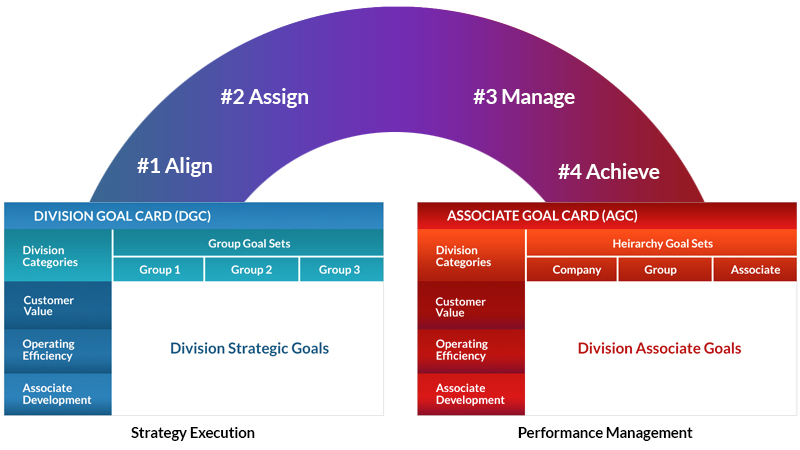STRATEGY MANAGEMENT
Benefits of Bridging the Gap
Benefits of Bridging the Gap
V2R has developed a web based, user friendly Strategy Management application that seamlessly bridges the gap between Strategy Execution and Performance Management.
Vision2Reality bridges the Strategy Management Gap by integrating an organization’s strategic goals, defined by its leadership team to gain competitive advantage, with the “No Excuses” individual associate level goals required to achieve them. Bridging the Strategy Management Gap aligns an organizations’ associates and helps them to work 10x more effectively to achieve its strategic plan.

Alignment is the first step in the Strategy Management process. Alignment assures that all division level strategies and associate level goals directly support the Organizations’ Vision, Mission and Values. Concisely defining the scope of every strategy and goal is huge challenge. V2R makes it much easier to assign the concisely defined goals in its web based application.
Strategy Management requires individual accountability for each aligned division level strategy and associate level goal. V2R is designed to support the assignment of all company level and supporting associate centric goals. Goal Priority, Stakeholders and a customized Rating Table are defined for each goal as part of the assignment process.
V2R makes it easy for Project Managers to cascade cross-functional accountability for each associate assigned to their project team. Metric goals are also an important component of the Strategy Management process. Even metric goals should have an individual associate assigned responsibility for achieving continuous improvement. These metric managers may also have cross-functional teams assigned to drive continuous improvement.
Chances are that the best laid plans will require agile corrective actions in order to successfully achieve them. This is where V2R provides ongoing management for previously aligned and assigned strategic level, associate centric and metric goals.
Goal Management assures that a goal Manager and Owner are jointly held accountable for successfully achieving every assigned goal. Ongoing meetings between Managers and Owners identify deviations from plan and monitor corrective actions taken to achieve the goal’s scoped requirements. This dual responsibility for all associate centric goals greatly improves the chances for timely and efficient achievement.
Achieve is where V2R manages the final assessment of all previously aligned, assigned and managed goals that have been completed. The integrity of every goal assessment is achieved when both the manager and owner perceive its rating to be fair.
Every associate in the organization is personally held accountable for successfully achieving their assigned goals. Goal Priority, Stakeholders and customized Rating Tables are defined when goals are assigned. Shortly after a prioritized goal is completed the predefined Stakeholders assess achievement based on the customized Rating Table. These focused and timely assessments help to achieve the required rating integrity.
The best way to assure an organization’s top and bottom line growth is to achieve a sustainable competitive advantage. Delivering more customer value, at less cost than your competition is the only way to achieve this advantage.
Achieving a sustainable advantage is becoming more of a challenge in today’s world of global competition. Patent laws still offer protection of intellectual property. However, advanced computer based design technologies allow competitors to circumvent existing patents by modifying products and processes that can now be done at light speed. As product commoditization occurs more rapidly, achieving a sustainable competitive advantage, based solely on products differentiation becomes more challenging.
Strategy Management requires the alignment of all associates in an organization with their selected strategic initiatives. A virtual bridge must be erected that spans the Strategy Execution to Performance Management gap to achieve the required alignment.
Closing the Strategy Management gap will always be a huge challenge, but achieving a sustainable competitive advantage also yields the greatest rewards.
The principles behind lean continuous improvement are sound. In today’s world of global competition all organizations must achieve continuous improvement in order to survive.
Driving continuous improvement in all organizations by definition requires ongoing change. Existing business processes must be documented and executed. The existing processes must be analyzed using lean principles leading to the development of more efficient processes. These new more efficient processes must then be documented and implemented at which time the continuous improvement process starts over again.
Strategy Management is a best practice process that helps organizations achieve continuous improvement by holding associates accountable for conformance to existing standards. In addition, Strategy Management also drives lean continuous improvement initiatives that when proven successful, supplant the existing standards.
A primary key to successful strategy management is the effective communication of an organization’s strategy and its translation into lower level group tactics and associate level goals. Automatically cascading company level strategy and group level tactics to the responsible associates across an organization is required to hold everyone accountable.
In today’s world of dynamic changes, an organization’s strategy must be validated on an ongoing basis and revised as necessary to remain competitive. As ongoing changes occur to the organization’s strategy, the corresponding lower level tactical and associate level goals must also be revised. A sound Strategy Management process will assure that these ongoing revisions are made and communicated in a timely manner.
Competing around the globe also requires associates located anywhere to collaborate with one another in order to bridge the gap. Bridging the global collaboration gap is an important aspect of Strategy Management and easily achieved within the V2R application.
Successful Strategy Management depends on concisely defined goals. Goals should be concisely defined and aligned with the organization’s strategies. Defining goals enables associates to understand their scope of responsibility and authority. Ongoing management provides them the feedback necessary to stay on track and forms the basis for periodic performance management and subsequent assessment.
Failure to clarify goals up front typically results in a wrestling match between the boss and associate during the year-end performance review process. When disagreements exist due to a lack of goal clarity, more energy may be expended trying to reconcile these differences, than it would have taken to concisely define them at the beginning of the review period.
Unfortunately, clarifying goal scope at the end of the year is too late. Poorly defined goals also force associates to rely on their best judgement throughout the year in hopes of meeting their boss’ expectations. This typically does not happen.
Strategy Management recognizes that there is a Manager and Owner responsible for each assigned goal. The Managers typically define the scope, assign the goal, make sure resources are available, track ongoing achievement, suggest corrective actions and rate the Owners performance upon completion.
Goal Owners are responsible for understanding and agreeing to complete their assigned goals on time and within budget. Goal Owners are also responsible for pulling out all stops to honor their commitments.
Strategy Management places equal emphasis on both the Manager and Owner roles. These dual roles overseeing the outcome of all strategically aligned, associate centric goals act as a belt and suspenders. This partnership increases the probability that the goal scope will be achieved on time and within budget.
The culture of any organization is established by the behavior of the critical mass of its population. Unfortunately, a prevailing culture that exists in most organizations is a lack of accountability. Poorly defined goals are informally assigned making associate level accountability impossible. In the absence of valid due dates, the relative priority of assignments is left to the whim of each associate. Due dates are regularly missed without consequences. The gap between Strategy Execution and Performance Management becomes so wide; they function independent of one another.
Strategy Management closes this gap by establishing associate level accountability for the effective and timely achievement of all goal assignments. Peer pressure takes over as accountability is restored that slowly shifts an organization toward a “No Excuses” culture. Once the critical mass embraces the “No Excuses” culture, the “can’t do” attitude will be replaced by a “can do” attitude. There’s nothing like peer pressure charged with a “can do” attitude that will get things done as required to close the Strategy Execution Gap.

